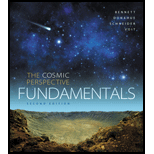
The group of particles having greatest mass among the given options.
Answer to Problem 1QQ
Among the given options, the group of particles that has the greatest mass is (c) four individual protons.
Explanation of Solution
Introduction:
The mass of particles is generally expressed in
A helium nuclide has a mass 4.002602 u
The mass of a proton in atomic mass units is 1.007276 u. Therefore, the mass of 4 protons is
The mass of an electron is 0.00054858 u. The mass of 4 electrons is
Conclusion:
Thus, it can be seen that the mass of 4 protons (4.0291 u) is the greatest among the three groups given. Hence the correct option is (c).
Want to see more full solutions like this?
Chapter 8 Solutions
The Cosmic Perspective Fundamentals (2nd Edition)
- See the screenshot uploaded. Answer in a step-by-step format, add diagrams, and detailed side notes for a better understanding. For a more clear response please answer on paper Thank you!arrow_forwardPLEASE be clear in your answer since the last time I posted was incorrect, and only answer part b, thanks.arrow_forwardNeed help with prob 2. Please show your work and box your answer thank youarrow_forward
- Please answer using the variables provided and show explanations and work spaced out. I cannot understand when its all typed together. Please circle final answers for each of the three parts.arrow_forwardHello, part D was incorrect, and where does the six come from?? I confused on reading the grapharrow_forwardSee the screenshot uploaded. Answer in a step-by-step format, add diagrams, and detailed side notes for a better understanding Ps. Please answer on paper Thank you!arrow_forward
- Solve the following problem and show your complete solutions. Explain your work for better understanding. And illustrate the FBDarrow_forwardRead the following items carefully. State your assumptions if any. Show your COMPLETE solution and BOX your final answers. Keep your answers and solutions in 4 decimal places. > Initially, 100 milligrams of a new radioactive substance Tobium, named after its discoverer Sir Tobs, was discovered and collected from one of the moons of Jupiter. After 6 hours from collection, the mass decreased by 4%, If the rate of decay IS proportional to the amount of the substance present at time t, find the amount of Tobium remaining after 48 hours.arrow_forwardWhy I got it wrong? Please help me to provide just few summary.arrow_forward
 College PhysicsPhysicsISBN:9781305952300Author:Raymond A. Serway, Chris VuillePublisher:Cengage Learning
College PhysicsPhysicsISBN:9781305952300Author:Raymond A. Serway, Chris VuillePublisher:Cengage Learning University Physics (14th Edition)PhysicsISBN:9780133969290Author:Hugh D. Young, Roger A. FreedmanPublisher:PEARSON
University Physics (14th Edition)PhysicsISBN:9780133969290Author:Hugh D. Young, Roger A. FreedmanPublisher:PEARSON Introduction To Quantum MechanicsPhysicsISBN:9781107189638Author:Griffiths, David J., Schroeter, Darrell F.Publisher:Cambridge University Press
Introduction To Quantum MechanicsPhysicsISBN:9781107189638Author:Griffiths, David J., Schroeter, Darrell F.Publisher:Cambridge University Press Physics for Scientists and EngineersPhysicsISBN:9781337553278Author:Raymond A. Serway, John W. JewettPublisher:Cengage Learning
Physics for Scientists and EngineersPhysicsISBN:9781337553278Author:Raymond A. Serway, John W. JewettPublisher:Cengage Learning Lecture- Tutorials for Introductory AstronomyPhysicsISBN:9780321820464Author:Edward E. Prather, Tim P. Slater, Jeff P. Adams, Gina BrissendenPublisher:Addison-Wesley
Lecture- Tutorials for Introductory AstronomyPhysicsISBN:9780321820464Author:Edward E. Prather, Tim P. Slater, Jeff P. Adams, Gina BrissendenPublisher:Addison-Wesley College Physics: A Strategic Approach (4th Editio...PhysicsISBN:9780134609034Author:Randall D. Knight (Professor Emeritus), Brian Jones, Stuart FieldPublisher:PEARSON
College Physics: A Strategic Approach (4th Editio...PhysicsISBN:9780134609034Author:Randall D. Knight (Professor Emeritus), Brian Jones, Stuart FieldPublisher:PEARSON





